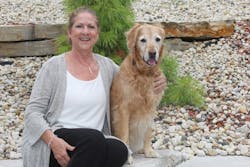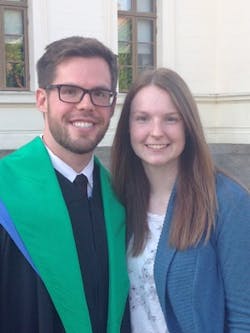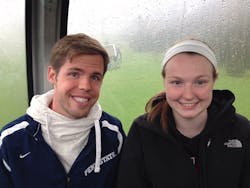Dynamic & Warm
Bob Crossen is managing editor for WWD. Crossen can be reached at [email protected].
When she qualified for the Olympic swimming trials at age 15, she did not realize how important water would be to the rest of her life. She was simply a lifeguard in Wisconsin who found success with the backstroke and a competitive drive. As a retiree starting in June 2018, Betty-Ann Curtis is finding enjoyment in smaller things: yoga, tiny homes and pride in her children’s success.
It is just like her to find pride in people other than herself. Curtis is the kind of person who tries to elevate those around her. She knows good company and strong relationships will take her further than self-centered goals and accolades.
Curtis was the pioneer for equipment manufacturer involvement in the Water Environment Federation (WEF) and its steering committee, and she has been fueled by her passion for the wastewater treatment industry since her first job with the Wisconsin Department of Natural Resources (DNR). Perhaps more important, however, is just how many strong relationships she has built along the way. Her peers view this as one of her most cherished and defining qualities.
Childhood & Career
As a child growing up in Shorewood, Wis.—a northern suburb of Milwaukee—Curtis’ association with water was a backdrop to her youth and early adulthood, throughout which she held a lifeguard position. She participated in swimming during those years, even competing through her second year of college for Lake Forest College in Lake Forest, Ill. Her swimming career started at age 5.
“My peak was back in the day when I was 12. I actually qualified for the Olympic trials time-wise [at 15],” Curtis said. “But I was pushing myself so hard that I did some damage to my shoulder. I was a backstroker, and so the summer that the trials were going to be held, I couldn’t go. My arm wouldn’t raise over my head.”
Despite the injury, she carried her competitive nature in swimming with her to the University of Wisconsin—Green Bay, where she was assistant coach to the UWGB Women’s Swim Team and completed a Bachelor of Science in environmental science. Upon graduating, she got a position with the Wisconsin DNR, which happened to deal
with wastewater.
“If I were to have taken a position in their drinking water division, it might have been different,” Curtis said. “The opening at the time was in wastewater and it was taking lab data and training operators how to do the tests better, more accurately and then how to use that data to run their plant more effectively.”
She held that DNR position for just shy of two years before realizing that she could be more successful and make more money as an engineer—like the people she was training. She attended Utah State University and graduated in 1985 with a Masters of Science in civil and environmental engineering. Immediately after graduation, she got a job with EIMCO Process Equipment Co.—known now as Ovivo.
Curtis worked for EIMCO for approximately 20 years, designing biological nutrient removal systems for “hundreds and hundreds and hundreds of plants.” Then, USFilter—which was subsequently bought by Siemens and then later by Evoqua—proposed an opportunity for her in Wisconsin in 2003 that Curtis said she could not pass up.
“They wanted to recruit me for a new brand they were introducing to the world and wanted me to launch it,” Curtis said. “They knew I was a native of Wisconsin and the time was right in my life being a single mom to move the family and the kids back here where family existed.” (See subtitle "Just the Three of Them" below.)
She stayed with the company 15 years, the last five of which she spent as director of sales for the wastewater division in North America. While she retired in June 2018, she was quick to note that the dynamism of wastewater treatment was the reason for her longevity in the industry.
A Puzzle at Every Plant
Throughout her career, Curtis’ focus has been municipal wastewater treatment, specifically biological nutrient removal. This singular focus since her first job with Wisconsin DNR gave her tremendous depth of knowledge and experience. More importantly, though, it kept her endlessly interested in and engaged with her work.
“I don’t think there’s been a month, a quarter or a year where I wasn’t learning something,” Curtis said, noting that when people spend several years in the wastewater industry, they have a tendency to stick with it for the rest of their working lives. “It just grabs you because it is always different and always challenging. It’s a great combination between art and science.”
The science, in this case, is the design of a treatment plant. It is finding that harmony between the processes that Curtis referred to as the art; how new technologies and innovations can enhance the greater work and improve the system. The concept of wastewater treatment as art can be lost on people outside the industry, but for Curtis it fueled her urge to learn and grow. “Every plant was a new puzzle,” she said, and similarly, every person gave her a new relationship to forge.
Working directly with operators at wastewater plants became an intimate experience for her. Curtis’ understanding and knowledge drove her credibility, but what would really ensure success was her personality and genuine desire to create personal relationships with people.
That quality was recognized by her peers, as well. John Dyson, AquaPrime product channel manager for Aqua-Aerobic Systems, is the chair of the Manufacturers and Representatives Committee (MARC) for WEF. He worked with Curtis on that committee prior to her retirement. Describing Curtis as a “ball of energy,” Dyson said Curtis’ passion for the industry and its people is unparalleled.
“It is hard to put it in words. Her actual involvement in the industry—she has maintained and stuck with doing the committee work and being involved,” Dyson said. “There are people who do a good job in the industry and there are people who do extra. She’s the type of person that did all the extra.”
That commitment to extra work was an extension of her personality in the office. Donald Scherwin, sales support manager for Evoqua Water Technologies, knew Curtis before she worked with Evoqua, and worked side-by-side with her and eventually for her. For Scherwin, Curtis always set a good example and had the tools to be not only a valuable coworker, but also a valuable person. He cherishes the personal connections he made with Curtis over the years and knows others in the industry feel the same way.
“Nobody holds a candle to her from the standpoint of her passion for the business, for the industry and for the betterment of the industry we are in and for the relationships that she has developed over the years,” Scherwin said. “Every level of the industry itself, she put all her energy into really developing good personal relationships with people. I’ve never seen anybody do a better job of doing that. She had more than a technical relationship with people.”
Curtis routinely attended the WEF Techincal Exhibition and Conference (WEFTEC) over the years (35, missing only one) and became a regular fixture on WEF committees and in the Evoqua booth on the show floor. What brought her joy at those shows was not only the pomp of the event, the opportunity to speak, and learning about new innovations—it was also when a client would visit the booth with the sole purpose of showing off pictures of their family.
“She made it a point to try to get to that level with everybody she met,” Scherwin said. “It was really just phenomenal to watch her and to see her do that.”
Trailblazer
Curtis championed equipment manufacturer involvement in WEF committees and developed the blueprint for how manufacturers can be involved with the steering committee. She had been asked by a chair to be on the wastewater symposium to review abstracts, which at the time was a rare opportunity for an equipment manufacturer. Through feedback not only on the abstracts submitted, but also on the process for scoring them and how to better that process, WEF asked her to join the MARC and to be a liaison to the steering committee as a voice for equipment manufacturers.
Mary Ann Linder, senior manager of education for WEF, said Curtis is “dynamite, dynamic and warm.” Curtis, she added, believed so much in the value of equipment manufacturer involvement with WEF that she fought hard to make it a reality. Curtis’ voice and direction became an invaluable resource for the organization and for Linder.
Words of Wisdom
- “We’ve always joked that any 10-year-old with 30 years of experience can do [wastewater treatment]. It’s not rocket science, but you need decades of exposure before you’re really good enough to make a big critical decision.”
- “Own your own career path. Don’t wait for someone to point you to the next step in your career. You change your job every year. Stay in your position and ask your supervisor for the next level of responsibility.”
- “Get involved with your company. Get involved in organizations you interact with [at state and national levels].”
- “Care about your end customer. We’re not successful with a technology or process until we’ve been successful with the customer. If that owner doesn’t love it, you’re not successful.”
“She made you think about how the program looks and feels for different audiences, and to always keep that in mind as you’re building it and to always question that,” Linder said. “Everyone is so busy. All volunteers are, and Betty-Ann you could always count on to just help. Now it feels like there’s a little void there, and you have to find that next person who is willing to do what Betty-Ann was willing to do. And that’s a rarity in these times.”
Similarly, Scherwin said Curtis had a great ability to distill her knowledge into understandable packages. Evaluating the audience and adjusting for that was a speciality.
“She has a very high level of technical expertise in all aspects of our business,” Scherwin said. “She can speak at any level, in any level with any person with relationship to the technologies we sell to this market.”
It was that ability that allowed Curtis to elevate equipment manufacturers with WEF when their presence was not as greatly felt. For Curtis, it all just made sense. Because equipment manufacturers lead innovation, they should be part of the conversation about the industry’s future. They should be propping up new ways to do things and they should have a stage to show that.
“It was so important to me because I always felt that equipment manufacturers are not the bottom of the totem pole,” Curtis said. “We might design 100 times more plants than [consulting engineers] do in a year. They design it differently because they’re at a different level than we are—they’ve got to take it down to the rebar and the structural level—but it’s just a different world in terms of what we provide to the industry. I wanted to provide a voice that actually elevated the standing of what an equipment manufacturer is.”
She said her biggest achievement on this front was starting the Manufacturers’ Innovation Forum at WEFTEC 2017. This allowed manufacturers to show conceptual ideas at WEFTEC before the technology had truly taken off. The innovations could have no more than five full scale installations. The process to be on the podium can take six to eight years, and she said this forum was designed to get creativity flowing with concepts being presented within one to three years. Its success in its first year has led WEF to include it again at WEFTEC 18 and beyond.
Curtis’ drive to elevate equipment manufacturers is part of a deeper goal to advance the industry into new territory. This issue, she noted, is laced with many subfacets, one of which is competitive bidding. Most municipalities these days seek competitive bids and pick the lowest price of the bunch without weighing other factors, such as customer service.
“That just wasn’t that way when I started because relationships mattered more, that trust that someone is not going to let you down,” Curtis said. “You had to earn that bid position. You had to prove value. You had to prove worth. In those days, bids meant something. ... I think that’s hurting the industry and that’s hurting the reputation of manufacturers.”
With competitive bidding, she said sometimes corners are cut to give a better price, and in other cases, the winner of the bid may not have the capabilities to carry out the project at scale. While that is not always the case, she said the human connection needed for bid-winning when she started seems to be lost. Contractors win the bids and make the selections, which creates an additional barrier between the suppliers and the municipalities looking for projects.
The greater problem with this model, she said, is in the stagnation of technological advancement.
“We can bring new technology, enhancements to technology and brand new ideas forward,” Curtis said. “But if we’re not given credit for that and you open it up to everyone and their brother bidding, well then manufacturers will stop investing if there can be no return.”
Just the Three of Them
Since 2003, Curtis has been a single mother. While living in Utah, Curits and her ex-husband divorced. She and her two children—Steven and Sarah, who were 12 and 8, respectively, at the time—moved back to Wisconsin, where Curtis continued her career and her children pursued education with vigor.
“I’ve raised these two kids virtually by myself,” Curtis said, “I had this big old house and two acres of land and I was a single mom starting a new job putting in some woefully long hours. But we pulled it off together, and they’ve both been hugely successful in Mom’s eyes.”
They’ve been successful from outsider’s perspectives, too. Steven is working on his Ph.D. at Lund University in Sweden, where he also completed his master’s degree. Curtis said his summer classes in 2018 included travel to different countries in Europe, with one course in Paris, one in Slovenia and a third in Vienna.
“He’s working really, really hard. He’s publishing articles. He’s teaching. He’s working on his thesis,” Curtis said. “He’s doing very very well and I’m proud of him.”
Sarah graduated from the University of Wisconsin—Madison in 2018 with a master’s degree in occupational therapy. In the summer of 2018, Sara was completing her fieldwork, which Curtis said is similar to residency for a medical student.
“I’m very proud of her and very proud of them. It was just the three of us figuring out this life together,” Curtis said.
As for Curtis’ parents and siblings, her father, Dick Naeger, was a farmer in his youth, and became a product manager in his adult life; her mother, Mary Naeger, was a secretary; her two brothers, Bob and John, live on the East Coast in New England; and her sister, Mary Therese, lives not far from her in Wisconsin. Both of her parents died in the early 2010s, and Curtis said she makes a point of visiting and speaking with her siblings regularly. In fact, she and her brother are building a tiny house together that they will share. It will be self-contained with solar panels, a generator and even a composting toilet. She said her brother will live in it during the six months of the year that she plans to live in Central America. Although Curtis has not nailed down the exact location just yet, she is considering Belize, Costa Rica and Panama for a permanent residence for her and her dog, Zoey.
“I know people from this industry in every single state, so they should all be warned that I could be driving into their town and onto their driveway to park at any time,” Curtis said.
Relaxation & Retirement
Now that she has retired, Curtis said she spends much of her time working on her 2-acre property in Wisconsin. She is proud of her landscaping and its natural look and feel.
And with more free time in retirement, she said she has been able to get back to exercise that she enjoys, namely yoga.
“You’re in a hot room, like 105 or 108ºF, and I absolutely love it,” Curtis said. “I’ve never minded heat. I can sit out in the sun on a 90ºF day and soak in the sun. I think I must be cold-blooded that I need that. I get in a car that’s parked in the sun and I don’t turn the air conditioning on and enjoy the toasty feeling for a while.”
She said sweating in hot yoga brings her a deep calm, and that afterward she feels cleansed in both mind and body. Curtis has found a good start to her retirement.


